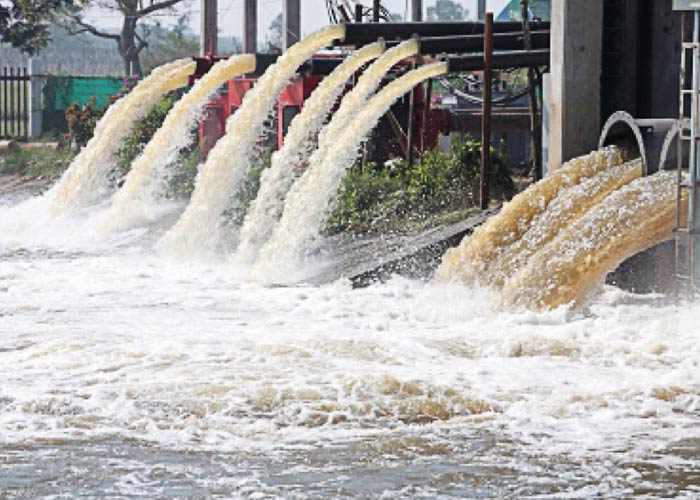Natural Resources Depletion
Natural resource depletion refers to the decreasing amount of resources left on the Planet Earth. It occurs when we use the resources at a rate faster than their renewal. It is indeed a very grave problem nowadays.
Why is Natural Resource Depletion a Problem?
In ancient times, human life was very close to nature. But with the establishment of large and heavy industries after the Industrial Revolution, indiscriminate exploitation of Nature started taking place to meet the need for raw materials for the industries. With the help of science and technology, man has grossly abused natural resources to meet the increasing needs of population and violated the laws of nature. The over-exploitation of natural resources has posed a big threat to the survival of mankind. Due to large-scale industrial waste, natural resources such as water and air have to face the pandemic of pollution too.
As a result of the implementation of big projects related to developmental activities, environment-related problems in the present era have acquired alarming proportions. In the race for development, we seem to forget that all natural resources such as water, air, minerals, forests, oils etc. are available in limited quantities. There is a need for conservation of natural resources which are becoming scarce with the passage of time. Their use exceeds the speed of their natural replenishment. Increasing pollution, global warming, industrialization and other processes have accentuated the depletion of natural resources.
Before taking a close look at the problem of resource depletion, let us understand what a natural resource is.
Meaning and Types of Natural Resources
A natural resource can be defined as anything that is obtained from the natural environment and which is of use to people. Some of the examples include air, water, wood, oil, wind energy, iron, coal etc. These are obtained directly from the environment. Other resources like refined oil and hydro-electric energy do not count in natural resources because they are not directly obtained from the environment.
There are basically two types of natural resources namely, renewable resources and non-renewable resources.
- A renewable resource is a resource which can be used again and again. These can renew themselves and are never depleted. Take for instance soil, sunlight, water. However, in some situations, even these are not easily renewed. Water is not easily renewable in some circumstances. Soil, is also not easy to renew if it blows away.
- A non-renewable resource is a resource which does not grow back, or a resource that usually takes a very long time to renew. These resources when exhausted once cannot be renewed. For example, coal. It is a non-renewable resource. When we use coal, lesser coal is left in the environment for future use.
Although renewable resources may seem like they will last forever, most of these natural resources are limited, meaning they will eventually be finished.
Whether the resource is able to be recycled, and whether there is availability of substitutes for the material are major factors affecting supply of resources. Non-renewable resources like fossil fuels (coal, oil and gas) cannot be recycled.
The problem of resource depletion arises here. When the resources are consumed at a rate faster than they can be replenished, it is termed as resource depletion. This includes the use of either of the renewable and non-renewable forms of resources. With increasing population and increasing demands of consumers, resources are being over-exploited and being depleted day by day. This is a serious problem as without these resources, humans cannot survive. We use natural resources like water, fossil fuels, and minerals on a daily basis and thus we need to conserve them too for future.
The gravity of the problem can be seen from the facts and figures which show that major resources like coal, natural gas etc. are being depleted at an alarming rate. Problems like food and water scarcity arise when resources aren’t available. Pollution and global warming are added consequences of this problem, which need to be taken care of for the harmony of human life on Earth.
Natural Resource Depletion Facts
Let us now have a look at some facts with regard to the depletion of resources:
- Water – Even though our planet is 70% water, only a small percentage of that is fresh water. The rest is salt water and not useful at all. The 2.5% of fresh water exists mostly as ice or permanent snow cover. Humans really have only a few percentages available for use. According to the prediction by The Food and Agriculture Organization (FAO) of the United Nations, by the year 2025 around 1.8 billion people will have no access to drinking water.
- Coal – This is the most commonly used fossil fuel. It is a non-renewable energy source. It is predicted that peak coal extraction will be done between 2025 and 2048. In 2011, it was predicted that we only have coal which can meet global demands for the coming 188 years. If the demand increases at a faster rate, the timeframe will decrease further.
- Oil – Global transportation will be severely affected without oil. According to The BP Statistical Review of World Energy, as of 2010, there is only 188.8 million tons of oil left in the oil reserves known to man. This oil will only be enough to meet the world demands for the coming 46.2 years keeping in mind the current demand.
- Natural Gas – With the current global production, as of 2010, the known reserves of natural gas were estimated to last the next 58.6 years.
- Fish – Fishermen from many coastal provinces report a decline in the amount of fish they catch. Marine species, for example, tuna is close to extinction because of overfishing. Since fish is part of our major food group, this is a very alarming situation.
- Phosphorous – It is used as a fertilizer which helps the plants to grow. Scientists from the Global Phosphorus Research Initiative (GPRI) estimated that phosphorous, that is derived from phosphorous rock and guano, will reach its peak by 2030.
Natural Resource Depletion Statistics
The facts and figures regarding the resource depletion are startling. By having a look at these statistics, one can have an idea of how grave the problem is. First the extraction of minerals from the earth: From 40 billion tons in 1980 to 58 billion tons in 2005, global resource extraction grew more or less steadily over the past 25 years. This represents an aggregated growth rate of 45%. The extraction of metal ores particularly increased by more than 65%; indicates the continued importance of this resource category for industrial development.
A person uses on an average 16 kilos of resources extracted from the earth every day – metal, fossil energy, and minerals. It is assumed that the production of mined metal commodities will increase by 250 percent by 2030.
Now coming to the depletion of an important resource like water, the statistics are enough to depict how serious the problem is. More than 700 million people in 43 countries suffer today from water scarcity. By 2025, 1.8 billion people will be living in regions with absolute water scarcity, and it is estimated that nearly two-thirds of the world’s population could be living under water stressed conditions.
Gravity of Natural Resources Depletion
Natural Resources are depleted when they are being used at a rate faster than they can replenish themselves. The problem began from the time of Industrial Revolution. As our culture advanced and humans invented many things that make our day-to-day lives easier, the demand for raw materials increased at a substantial rate.
The problem is, we’re consuming a lot without caring about the depletion of these resources. If this trend continues, soon we will have to lead a life devoid of many substances which means resources like fossil fuels will longer be available. This is surely a scary scenario since our daily lives without these resources are unimaginable. Moreover, problems like water scarcity and food shortage arise when there is colossal waste of resources available with us.
Also, if there is shortage of fossil fuels, there will be less transportation, smaller economies and higher prices of commodities. Deforestation or cutting down of forests; results in a major loss of resources like wood, paper etc. It also causes global warming and rise in pollution levels. In addition to this, many species become extinct.
Causes of Natural Resources Depletion
The major causes of resource depletion are listed below:
- Overpopulation – With increasing population, demands of the country increase which further results in depletion of resources.
- Over-consumption and waste – As the standards of living of people improves, they tend to consume more and waste even more.
- Deforestation and the destruction of ecosystems – Forests are cut annually, to make space for multiplexes, residential complexes etc. This not only destroys trees (and wood as a resource) but also destroys home of thousands of species of animals.
- Mining – Mining of Minerals and Oil-Minerals and metals are in high demand in today’s world. This is a very big problem as ores are being depleted day by day.
- Technological and industrial development – Technology advances and so the need of resources increases.
- Soil erosion – Because of deforestation, soil erosion takes place. Thus, soil gets devoid of important minerals and resources.
- Pollution and contamination of resources – Water pollution, soil pollution is increasing at an alarming rate today due to negligent attitude of people towards the environment. Pollution has a direct effect on contamination of resources available in nature.
Effects of Natural Resources Depletion
The depletion of natural resources has widespread consequences not only on the human life but the environment too. Some of these are as listed below:
- Resource Scarcity: Resources like fossil fuels, timber, water and arable land become scarce because of over-consumption and degradation, mostly in the areas of tremendous population growth.
- Rising Prices: When natural resources become scarce, food, fuel and energy prices rise. Even the price of renewable resources increases if they need to be shipped to reach areas where these have been depleted.
- Water Shortages: When infrastructure development and population growth increase, water shortages occur. As of today, almost 1 billion people lack access to clean water.
How do Human Activities Affect the Natural Resources?
Natural resources are profitable to the mankind in various ways and thus humans take them for granted. Indiscriminate use of the natural resources has led most of these to become scarce. The natural resource depletion starts from the human aspiration for more and luxuries of life. Thousands of hectares of forests have been destroyed to build the major cities of world. The deforestation leads to destruction of natural resources. This results in loss of green cover. Along with this, the wildlife suffers from habitat loss which causes them to migrate and eventually get extinct. Another activity affecting resources is the overuse of mines for the production of human luxuries.
The water changes its composition and gets toxic when humans settlements dispose waste to the water resources like river and in the beaches. The fact that natural resources can’t remain pure also contributes to their depletion.
Natural Resource Depletion in India
The management of natural resources for economic development of any country is an important aspect. This is even more important in Indian conditions, because with the prudent use of limited natural resources, food can be adequately produced for the growing population.
India is facing an ecological crisis with degradation of its natural resources day by day. The nation is expected to surpass China as the world’s most populous country by 2025. As the Indian population rises rapidly and over-exploitation of land and water resources continues, the natural resources are at stake. There is increasing deficiency of energy, metals, coal, non-fuel and non-metallic materials. With regard to fuels, there is great concern over the increasing use to meet human desires.
Every year enough oil is purchased from countries in the Middle East which are major sources of petroleum. The developed nations of the world have access to abundant resources but the developing nations like India still have to import many of these from foreign countries. Another problem is the pollution of environment. In India, people in rural areas do not have access to clean water. As of today, 163 million Indians lack access to safe drinking water.
There is unequal distribution of natural resources in many areas of the country. Therefore, natural resources require very careful and optimum use and need to be protected. About 146.82 lakh hectares of land has been affected in India due to soil, water and air erosion and other complex problems such as alkalinity/salinity, and soil acidity.
In addition to it, the use of inappropriate chemical fertilizers has adversely affected soil fertility and nutrients. Many parts of our country are affected by drought and flood. The country’s large terrain depends on rain for agriculture. Due to heavy deforestation and soil depletion, in many areas rainwater is not absorbed in the soil. Groundwater available for agricultural and other uses is also being exploited.
Solutions to Prevent/Reduce Natural Resource Depletion
The likely solutions to reduce the resource depletion are as follows:
- Reduced Use of Fossil Fuels: We can conserve fossil fuels by using less gasoline and electricity. Driving less and saying yes to carpooling are simple ways to conserve gasoline. Buying a vehicle having high fuel mileage and purchasing Energy Star appliances can also contribute to conservation of fossil fuels.
- Keep Water Clean: Water may seem like a never-ending resource which is found everywhere, but due to population growth, the access to clean water for large populations decreases. Water can be saved by taking small steps in and around your home. Some of these include checking for water leaks and replacing or fixing leaky faucets.
- Preserve Trees and Forests: To satisfy the world’s need for paper alone, approximately 4 billion trees are g cut down per year. Thus, preventing the deforestation is very necessary. One can greatly contribute in this context by using less paper, using more cloth towels and not paper ones or by switching to an online-only subscription of your favourite newspaper. During a visit to a local forest, one should act responsibly and make sure that campfires are safely maintained.
- Protect Coastal Ecosystems: Coastal ecosystems are very important for maintaining biodiversity, but they are also extremely valuable for industries like fishing and tourism industries. Seafood consumers should keep in mind how their purchasing decisions can affect the environment. Reefs are extremely sensitive to disturbances. Diving or snorkelling around a reef should be done while treating the reefs with care and respect.
Conclusion
We have seen that the problem of natural resource depletion is indeed a very serious one. The increase in population and excessive human desire for all amenities of life are some of the major reasons behind it. Activities like deforestation, over-consumption and wastage of resources further lead to depletion. If we do not pay heed to this problem now, soon the Planet Earth will be devoid of many of the natural resources. This will have major impacts on human existence and also the environment.
Among the proposed solutions are switching to alternate energy such as solar power and wind power and responsible use of resources. We must embrace the concept of sustainable development. Development that meets the needs of the present without compromising the needs of the future generations is referred to as sustainable development. We should use resources in such a way that the needs of the present are met and also suitable amount is left for the future generations to use.
The goals of economic and social development can be achieved by ensuring terms of sustainability in both countries – either developed or developing. But we also require attitudinal change to sort out the problem of resource depletion. If our attitude towards natural resources remain apathetic, then the day is not far when very existence of life on the earth will be threatened. It’s time we realize that our actions are harming the planet and its resources, and we need to conserve, not destroy them by irresponsible activities. Only then the world can survive and maintain its equilibrium.







